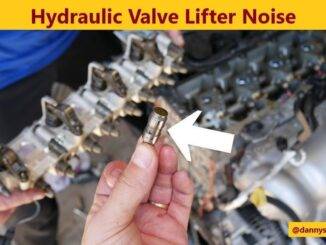
Valve lash setting, is something most drivers, don’t even think about.
First, you need to know, if you even have an adjustable valve train, for valve lash setting.
In most cases, you will not have to worry about, a valve lash setting. And, some manufacturers advise valves should be inspected, only if there is excessive valve train noise.
However, others don’t even mention, valve lash setting clearances, in their maintenance schedules. So, either check your owner’s manual or call your dealer, to find out for sure.
Listen For A Ticking Valve Noise
Usually the need for a valve adjustment, is determined by their sound. More accurately, the louder the ticking noise made in the valve train, the greater the need for adjustment. Properly adjusted valve lash, will be quiet. Some engines will always have, a light tapping noise. But, they should never be so loud as to, mask all the other noises the engine makes.
Note: Knowing when the valves are too loud is a matter of experience. Not to mention, they very gradually become louder and we are often oblivious to this fact. If you’re not sure, find someone with experience, to help you determine the need for adjustment.
If Yours Are Adjustable, There Are Some Warning Signs, They May Need Attention:
- Poor running engine and low performance.
- Burnt exhaust valve(s).
- Broken valve train components (springs, pushrods, lifters, camshaft).
- Limited or reduced life span of valve train components.
- Excessive valve guide and valve seat wear.
So, over time the original clearances (valve lash) , between the valve stems, become bigger. (with exhaust valves, the clearance can become tighter). That often leads to a clattering noise, that a driver might not notice over time, because it increases gradually.

Intake valves open and close to let the air/fuel mixture, (or just air in modern engines) enter the combustion chambers. Consequently, the exhaust valves, allow exhaust gases to escape. Too much or too little valve clearance, can result in poor performance or a rough idle. This is because, the engine can’t “breathe” normally and operate at peak efficiency.
So, too much (valve lash) clearance, means the valves will likely clatter and over time, cause damage to the:
- Valves
- Camshaft lobes
- Rocker arms
But, if there’s too little (valve lash) clearance, the valves won’t fully close. Causing excessive heat and the engine will lose power.
If your engine generates a loud clatter, it could be time for, a valve lash setting adjustment. Though on some engines the valves don’t generate noise, when there’s too much clearance.
Loss of power, could be a sign of a weak or broken valve spring. And, a tapping noise, could be caused by, a loose rocker arm.
So, a clearance adjustment, may not be all that’s needed. As a result, the mechanic won’t know for sure, without inspecting the valves.

Adjusting valve clearance (or “lash”) requires, removing the valve cover (or covers on V-type engines). It could take a fair amount of time, to checking both intake and exhaust valves. It’s not a quick job, like an oil change, especially on engines that have, three or four valves per cylinder. So, plan on at least a few hours at the shop and a charge, just for the inspection.
Eliminating valve clatter, is one benefit of adjusting the clearance. Also, the engine will likely become smoother and more responsive. In addition, correct valve lash setting, can extend the life of the valve system.

The purpose of a valve adjustment, is to bring the clearance, between the tip of valve stem and the camshaft lobe or rocker arm, back into the specified clearance, that was determined by the design engineer.
As the camshaft rotates, it pushes on the valve stem. Either directly or by using a rocker arm, to open the valves, inside the combustion chambers at the proper time. Finally, the valve springs will automatically, close the valves.

If the valve clearance is too small, the valves will never fully close, when they should. As a result, this will eventually burn part of the valve surface off, causing a constantly misfiring engine. But, if the valves are too tight, the engine may run rough, either cold, hot or all the time.
If the valve clearances get too loose, this will lead to a noisy running engine. Consequently, this will eventually damage the camshaft lobes, rocker arms and the tips, of the valves themselves.
Conclusion
So, setting the valve lash, for the first time, can seem like a scary task. But, as often as it’s over looked, it’s extremely important, to get the best performance out of your engine.
BY DANNY BENDER




